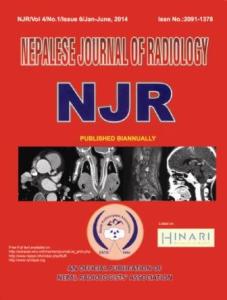Role of Dynamic Contrast Enhanced MRI in Characterization of Breast Lesions
DOI:
https://doi.org/10.3126/njr.v4i1.11366Keywords:
Breast, Benign, Malignant, MRI, DCEAbstract
Purpose: To assess the role of Dynamic contrast enhanced magnetic resonance imaging in characterization of breast lesions and to differentiate benign from malignant lesions on the basis of their morphology and enhancement kinetics.
Material and Methods: Sixty patients referred to the department of Radiodiagnosis for breast MRI over a period of twenty months were included. Dynamic contrast enhanced (DCE) Magnetic Resonance Imaging (MRI) was performed to differentiate breast lesions on the basis of morphology and enhancement kinetics. The lesions were classified accordingly into type I (progressive enhancement) Type II (plateau) and Type III (washout) kinetics. Morphology and curves of benign and malignant lesions were compared.
Result: fifty one benign lesions were detected in 32 patients and 29 malignant lesions were seen in 22 patients, whereas six patients showed normal MRI. It was found that benign lesion were round or oval in shape with well circumscribed margin and showed homogenous contrast enhancement whereas malignant lesions were irregular with spiculated margin and showed heterogenous contrast enhancement. The distribution curve types of benign lesion were Type I (81.25%-26cases), Type II (18.25%-6cases). For malignant lesions Type I (4.54%-1case), Type II (22.72%-5cases) and Type III (72.72%-16cases).
Conclusion: The shape of the time- signal intensity curve were an important criteria in differentiating benign from malignant lesions in dynamic breast MR imaging. A type III time curve is a strong indicator of malignancy and is independent of other criteria.
DOI: http://dx.doi.org/10.3126/njr.v4i1.11366
Nepalese Journal of Radiology, Vol.4(1) 2014: 23-33
Downloads
Downloads
Published
How to Cite
Issue
Section
License
This license enables reusers to distribute, remix, adapt, and build upon the material in any medium or format, so long as attribution is given to the creator. The license allows for commercial use.




